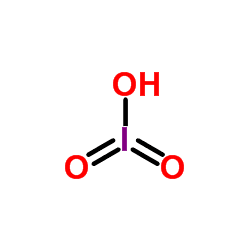Formula HIO3 Density 4.62 g/cm³ Appearance White solid | Molar mass 175.91 g/mol Melting point 110 °C | |
 | ||
Related compounds | ||
Iodic acid, HIO3, can be obtained as a white or off-white solid. It dissolves in water very well, but it also exists in the pure state, as opposed to chloric acid or bromic acid. Iodic acid contains iodine in the oxidation state +5 and it is one of the most stable oxo-acids of the halogens in its pure state. When iodic acid is carefully heated, it dehydrates to iodine pentoxide. On subsequent heating, the iodine pentoxide further decomposes, giving a mix of iodine, oxygen and lower oxides of iodine.
Contents
Preparation
Iodic acid can be produced by oxidizing I2 with strong oxidizers such as Nitric acid HNO
3, Chlorine Cl
2, Chloric acid HClO
3 or Hydrogen peroxide H
2O
2, for example :
2 + 6 H
2O + 5 Cl
2 ⇌ 2 HIO
3 + 10 HCl.
Properties
Iodic acid is a relatively strong acid with a pKa of 0.75. It is strongly oxidizing in acidic solution, less so in basic solution. When iodic acid acts as oxidizer, then the product of the reaction is either iodine, or iodide ion. Under some special conditions (very low pH and high concentration of chloride ion, e.g. in concentrated hydrochloric acid), iodic acid is reduced to iodine trichloride, a golden yellow compound in solution and no further reduction occurs. In the absence of chloride ions, when there is an excess amount of reductant, then all iodate is converted to iodide ion. When there is an excess amount of iodate, then part of the iodate is converted to iodine.It may be used in preparation of ionization to form alkyl halide
Uses
Iodic acid is used as a strong acid in analytical chemistry. It may be used to standardize solutions of both weak and strong bases, with methyl red or methyl orange as the indicator.
Use in salt industry
Iodic acid can be used to synthesize sodium or potassium iodate for increasing iodine content of salt.
